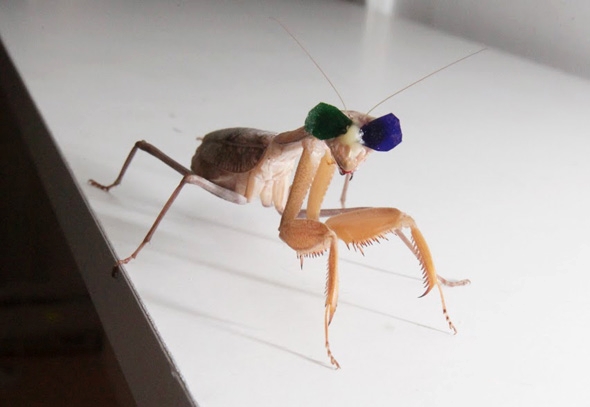
Proving that science really can be fun, the team at Newcastle outfitted a group of praying mantises with teeny tiny blue and green 3D glasses (attached to their heads with beeswax) and then set up a miniature 3D cinema for them to enjoy. And while I imagine these insects (for all their other impressive skills) lack the ability to appreciate, say, the latest Star Wars movie, they were still shown a “film” that involved simulated bugs moving about, which represented prey. And as it turns out, the “insect 3D cinema” provided “clear and dramatic proof of stereopsis in insects.”
Scientists found that when they showed the mantises footage of 3D prey-like images, the insects actually reached out, attempting to strike the screen. But this same effect was not observed when 2D images were shown instead. This suggests that the mantises indeed have some form of depth perception, and can tell when things appear to be coming at them, instead of staying on a single plane.
“Despite their minute brains, mantises are sophisticated visual hunters. We can learn a lot by studying how they perceive the world,” Jenny Read, a vision science professor at Newcastle who led the study, said in a statement. “Better understanding of their simpler processing systems helps us understand how 3D vision evolved, and could lead to possible new algorithms for 3D depth perception in computers.”
So really, it’s not just about how the praying mantises see — the implications of this research are practically endless.
“3D vision has loads of applications, like robot navigation,” Ghaith Tarawneh explained to the Christian Science Monitor. “Robots rely on getting information from the environments. You want the robot to understand somehow its environment and perhaps move towards particular goals and it needs some sort of understanding of the environment based on visual input.” Which is to say, thanks praying mantises. You’ve no idea the impact you’ve just had on the world at large.
Editors' Recommendations
- Nvidia turns simple text prompts into game-ready 3D models
- AMD is bringing 3D V-Cache back to Ryzen 7000 — but there’s a twist
- AMD teases performance of its revolutionary 3D V-cache chip
- AMD’s 3D-stacked Ryzen 7 5800X3D is ‘world’s fastest gaming processor’
- Need a last-minute Halloween costume? Check out these 3D-printable getups


